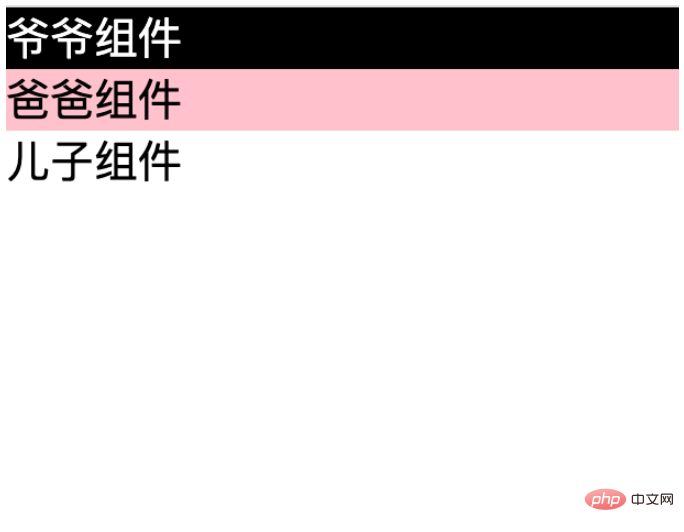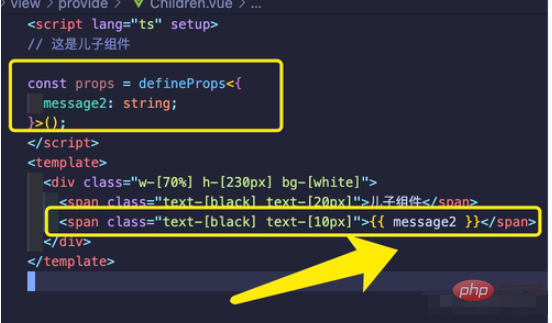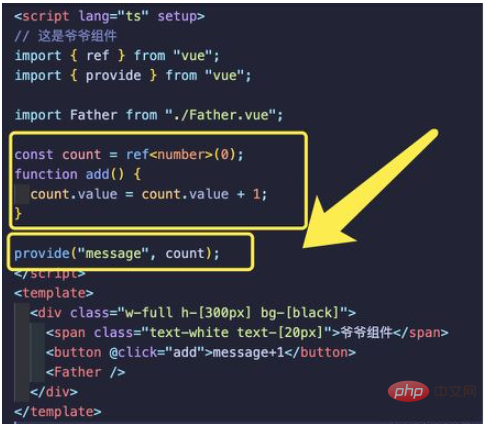Home >Web Front-end >Vue.js >How to use provide and inject in Vue3
How to use provide and inject in Vue3
- WBOYWBOYWBOYWBOYWBOYWBOYWBOYWBOYWBOYWBOYWBOYWBOYWBforward
- 2023-05-11 23:52:042167browse
1. Scene reproduction
Don’t worry about the meaning of the API title. Here I will start by writing a more common scenario. The internal code of the component corresponding to
is relatively simple, and I will not show it here. Logically, these three components are referenced layer by layer.

The corresponding page effect is as follows:

As shown above, this is a very common one in the project Scene, three levels of nested components. (In fact, there are still deep levels of nesting. At present, we take three-layer nesting as an example)
ok, your current demand is: in grandpa component A string data "Han Zhenfang" needs to be provided to be used by the son component.
You must have thought of props if you are smart. Without further ado, let’s get started.
2. Passing Props
"How advanced I thought it was. Isn't this the scenario where data is passed from father to son? I pass props directly. To complete this requirement." So I will write such a piece of code in
GrandFather.vue Then it’s time to go
Then it’s time to go
The component is going to receive this data. So we defined props in the Father.vue component to receive this value.
 Let’s take a look at the page
Let’s take a look at the page
 No problem,
No problem,
has been received. But don’t forget that our task has not been completed yet. Our requirement is to be used by son component, so we quickly pass it on.
 So now our
So now our
component looks like this.
 The page effect is as follows:
The page effect is as follows:
 In the end, our
In the end, our
was indeed obtained. Did you find anything wrong while writing this? ????
In fact, our
Dad component does not need to know these properties at all, it just acts as a passing microphone. It would be fine if this component was only used in this one scenario, but once we want to reuse the Dad component in a second place, we will find that a problem arises. We must provide this Dad component with a props called message1, but in fact this message1 is not a Dad component An attribute used internally. As you write this, you have discovered that just passing one more layer makes the reusability of the component very poor. This is still a scene with only three levels of nesting. Once you reach the fourth level, you will find that things gradually start to get tricky. It seems that
is not a good choice. Thinking of this, you will start to think, is there a better solution? Don't tell me, there really is. That is our protagonist today,
and inject. 3. provide and inject
First of all, don’t memorize the name of the API. The author must have a reason for naming it. In many cases we first look at the meaning of these two words.

 You can probably guess a rough meaning from the meanings of these two words alone. One is
You can probably guess a rough meaning from the meanings of these two words alone. One is
A certain value, the other is to register , receive this value. Then the question arises, how do we use these two APIs correctly? It's actually very simple. Let's go back to the
Grandpa componentand restore his original appearance.
 You only need two steps:
You only need two steps:
Perhaps you will be surprised, is this all? Let me tell you clearly, yes, this will do.
The last step is to go to son component to receive and use it and you are done.

Let’s take a look at the page effect:

Not only was the data successfully obtained, but the key is ourDad Component is clean and does not affect its references elsewhere.

Let’s go back and explain the usage of provide. provide Accepts two parameters. The first parameter needs to be a unique identifier (the same name as a variable inside the component is not allowed), and the second parameter is the value to be passed.
You can also understand it this way, now Grandpa Component is holding a loudspeaker and shouting????: "Who wants "Han Zhenfang", who wants" #汉正方’, the price is cheap, and you only need one‘message’”.
son component heard the news and shouted: "I want it, I want it!!" So it quickly inject a "message ".

Note: The variable name you use to accept is randomly chosen, and you do not need to be consistent with the previous one.

Dad component doesn’t want it at all, so it doesn’t need inject at all.
Andinject also allows you to have a hiding behavior. What does it mean? Suppose this son component also needs to be reused in other places, but its grandfather component or does not have a grandfather component at all, then the second parameters will be used as the default values for suibian.

provide behavior of the grandpa component.

understanding data.

provide is much more than just providing the string type It's just data. Let's try declaring a responsive data in Grandpa Component.

son component has grown up, it says that I also want to control the growth of the number, is that okay? Grandpa Component is very fond of grandson, so he provides a method for grandson to use.

Son componentCan you really control it yourself? Has the child really grown up?

son component is indeed grown up (referring to the successful inject #Grandpa component provide function)
Don’t turn around and forget, the second parameter is our cover-up behavior. If grandpa doesn't provide a function, I'll use an arrow function myself that has no behavior. That's all.
 5. Source code
5. Source code
<script lang="ts" setup>
// 这是爷爷组件
import { ref } from "vue";
import { provide } from "vue";
import Father from "./Father.vue";
const count = ref<number>(0);
function add() {
count.value = count.value + 1;
}
provide("message", count);
provide("messageAdd", add); //我把 add 也同时提供给儿子组件
</script>
<template>
<div class="w-full h-[300px] bg-[black]">
<span class="text-white text-[20px]">爷爷组件</span>
<button @click="add">message+1</button>
<Father />
</div>
</template>
<script lang="ts" setup>
// 这是父亲组件
import Children from "./Children.vue";
</script>
<template>
<div class="w-[70%] h-[270px] bg-[pink]">
<span class="text-[black] text-[20px]">爸爸组件</span>
<span class="text-[black] text-[15px]"></span>
<Children />
</div>
</template>
<script lang="ts" setup>
// 这是儿子组件
import { inject } from "vue";
const suibian = inject("message", "假如爷爷没提供没有的话就用我");
const add = inject("messageAdd", () => {});
</script>
<template>
<div class="w-[70%] h-[230px] bg-[white]">
<span class="text-[black] text-[20px]">儿子组件</span>
<span class="text-[black] text-[10px]">{{ suibian }}</span>
<button @click="add">长大了,我自己+1</button>
</div>
</template> Six. Thinking questions
If I now
grandfather componentsand The father component also provides the same keyword value. The son componentwhose one will be used in the end? GrandFather.vue: => provide("message","provided by grandpa component");Father.vue: =>provide("message"," Provided by the parent component")Children.vue:=> inject("message","Whose one do I use?")
The above is the detailed content of How to use provide and inject in Vue3. For more information, please follow other related articles on the PHP Chinese website!
Related articles
See more- About vue using validator: VeeValidate3
- What are the differences between computed and method in Vue?
- Introduction to the method of turning off Eslint verification in the vue project
- Introduction to several methods of defining component templates in Vue.js
- Four places to implement AJAX in Vue applications

